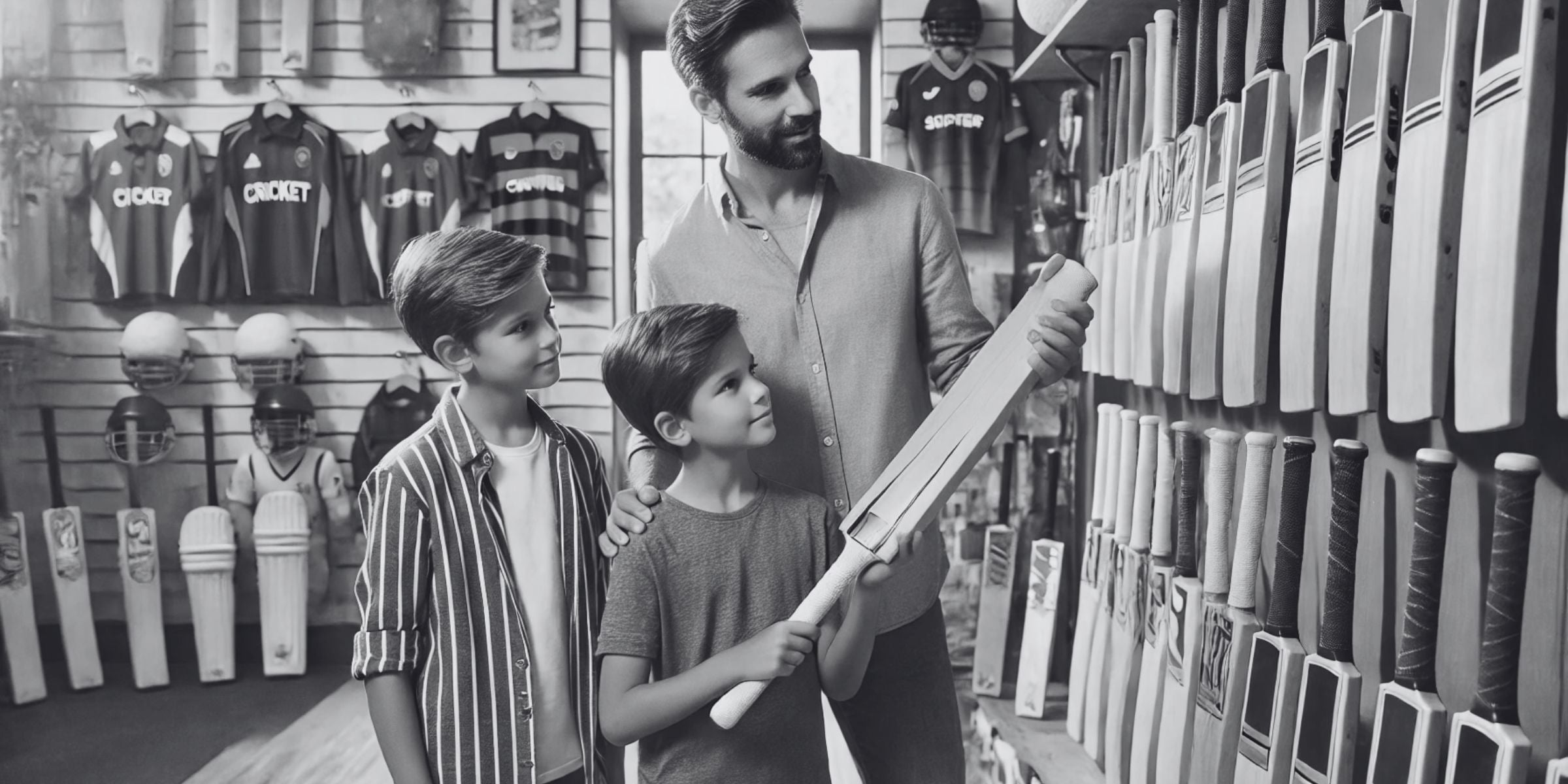Article: How to Choose a Bat for Junior Players

How to Choose a Bat for Junior Players
How to Choose a Bat for Junior Players: A Guide for Parents and Coaches
Choosing the right cricket bat for a junior player is a crucial step in nurturing their love for the game and helping them develop their skills. For young cricketers, the right bat can make all the difference in their confidence, performance, and enjoyment. In this comprehensive guide, we’ll cover everything parents and coaches need to know about selecting age-appropriate bat sizes, lightweight options for kids, and tips for encouraging young players to excel.
Why Choosing the Right Bat Matters for Junior Players
For young cricketers, the right bat is more than just equipment—it’s a tool that can inspire confidence and foster a love for the game. A bat that’s too heavy or too long can hinder a child’s development, while the right size and weight can help them play naturally and enjoyably. Here’s what to consider when choosing a bat for a junior player:
1. Age-Appropriate Bat Sizes
The size of the bat is one of the most important factors to consider. A bat that’s too long or too short can affect a child’s stance, grip, and ability to play shots effectively. Here’s a general guide to bat sizes based on age and height:
| Age Group | Player Height | Bat Size (Length) |
|---|---|---|
| 4-5 years | Under 4'0" (122 cm) | Size 0 (24-26 inches) |
| 6-7 years | 4'0" - 4'6" (122-137 cm) | Size 1 (26-28 inches) |
| 8-9 years | 4'6" - 4'9" (137-145 cm) | Size 2 (28-29 inches) |
| 10-11 years | 4'9" - 5'0" (145-152 cm) | Size 3 (29-30 inches) |
| 12-13 years | 5'0" - 5'4" (152-162 cm) | Size 4 (30-31 inches) |
| 14-15 years | 5'4" - 5'8" (162-173 cm) | Size 5 (31-32 inches) |
| 15+ years | Over 5'8" (173 cm) | Size 6 (32-33 inches) |
Tip: Always consider the child’s height and strength rather than just their age. A taller or stronger child may need a slightly larger bat.
2. Lightweight Options for Kids
Junior players need bats that are lightweight and easy to handle. A heavy bat can strain a child’s muscles, affect their technique, and discourage them from playing. Here’s what to look for in a lightweight bat:
-
Weight Range: Junior bats typically weigh between 800 grams (1.8 lbs) and 1.1 kg (2.4 lbs). Younger players should start with the lightest options and gradually move to heavier bats as they grow stronger.
-
Pick-Up: The bat should feel comfortable and easy to lift. Test the pick-up by having the child hold the bat in their stance and swing it gently.
-
Material: Look for bats made from lightweight English willow or Kashmir willow. These materials are durable and provide a good balance of weight and performance.
3. Tips for Encouraging Young Players
Choosing the right bat is just the first step. Here are some tips to help young players develop their skills and love for the game:
a. Focus on Fun
-
Make practice sessions enjoyable by incorporating games and challenges. For example, set up targets for them to hit or organize mini-matches with friends.
b. Teach Proper Technique
-
Start with the basics: grip, stance, and backlift. Encourage them to play straight drives and defensive shots before moving on to more advanced strokes.
c. Use Age-Appropriate Equipment
-
In addition to the right bat, ensure they use soft balls or tennis balls when starting out. This reduces the risk of injury and builds confidence.
d. Celebrate Small Wins
-
Praise their efforts and improvements, no matter how small. Positive reinforcement boosts their confidence and motivation.
e. Be Patient
-
Every child learns at their own pace. Avoid putting too much pressure on them to perform. Instead, focus on their enjoyment and progress.
4. Maintenance Tips for Junior Bats
Teaching kids to care for their bats is an important part of their cricketing journey. Here are some simple maintenance tips:
-
Knock In the Bat: New bats need to be knocked in to compress the fibers and prevent damage. Spend at least 4-6 hours knocking in a junior bat before use.
-
Oil the Blade: Apply a light coat of raw linseed oil to the blade to keep it moisturized and prevent cracks.
-
Store Properly: Keep the bat in a cool, dry place and avoid exposing it to extreme temperatures or moisture.
-
Use a Bat Cover: Protect the bat from scratches and damage by using a bat cover.
5. When to Upgrade the Bat
As children grow, their bats will need to be upgraded to match their size and strength. Here are some signs it’s time for a new bat:
-
The bat feels too short or light for the child.
-
The child has outgrown their current bat size.
-
The bat shows signs of wear and tear, such as cracks or splinters.
Conclusion
Choosing the right bat for a junior player is a thoughtful process that can significantly impact their cricketing journey. By selecting an age-appropriate, lightweight bat and encouraging them with patience and positivity, you can help young players develop their skills and fall in love with the game. Remember, cricket is not just about performance—it’s about enjoyment, growth, and creating lasting memories.
_____________________________________________________________
All Zee Sports Cricket Bats Pages Links.
https://zeesports.co/collections/elite-bats https://zeesports.co/collections/dsc-cricket-bats
https://zeesports.co/collections/all-cricket-bats https://zeesports.co/collections/english-willow-bats https://zeesports.co/collections/ss-cricket-bat https://zeesports.co/collections/gray-nicolls-cricket-bats
https://zeesports.co/collections/sg-cricket-bat
https://zeesports.co/collections/kookaburra-cricket-bat
https://zeesports.co/collections/zeesports-cricket-bats
https://zeesports.co/collections/new-balance-cricket-bat
https://zeesports.co/collections/spartan-cricket-bat
https://zeesports.co/collections/batting-gloves
https://zeesports.co/collections/bat-accessories
https://zeesports.co/collections/youth-cricket-bats-2
https://zeesports.co/collections/kashmir-willow-bats
https://zeesports.co/collections/a2-cricket-bat
https://zeesports.co/collections/salix-cricket-bat
https://zeesports.co/collections/clearance-bats
https://zeesports.co/collections/ihsan-cricket-bat
https://zeesports.co/collections/slazenger-cricket-bat
https://zeesports.co/collections/reebok-cricket-bats
https://zeesports.co/collections/tape-tennis-bats-1
https://zeesports.co/collections/mb-malik-cricket-bat
https://zeesports.co/collections/hs-cricket-bat
https://zeesports.co/collections/boom-boom-cricket-bats
https://zeesports.co/collections/mids-cricket-bat
https://zeesports.co/collections/hunts-county-cricket-bat
https://zeesports.co/collections/mrf-cricket-bat
https://zeesports.co/collections/puma-cricket-bats
https://zeesports.co/collections/bdm-cricket-bats
https://zeesports.co/collections/ca-cricket-bats
https://zeesports.co/collections/mb-cricket-bat
https://zeesports.co/collections/robinson-cricket-bat
https://zeesports.co/collections/gm-cricket-bats
https://zeesports.co/collections/sf-cricket-bat
https://zeesports.co/collections/fiberglass-bat
https://zeesports.co/collections/matador-cricket-bat
https://zeesports.co/collections/protos-cricket-bat
https://zeesports.co/collections/hard-tennis-bats


Leave a comment
This site is protected by hCaptcha and the hCaptcha Privacy Policy and Terms of Service apply.